Guess what?
On the way in to Datong, my guide pointed out the new buildings on the far side of the river, which included the government center, apartment buildings, and so forth. She noted that the government decided to move away from the older area of the city to foster tourism, and prepare for the day when the coal mines, the backbone of the local economy, give out. Somebody must be reading my blog!
The question I had, however, was—what does Datong have that would attract tourists? Of course, it has (like everywhere in China), at least 2,000 years of history, but what’s left? And what will attract people to come here? That was the quest for today.
My conclusion is that if it’s your first trip to China, and you have two or three weeks, Datong is not likely to be on your list. But in the name of fairness, let me tell you about the attractions of the city and area, which, if it doesn’t sway you to put Datong on that first trip list, might encourage a visit sometime; bear in mind, it took 22 years of China visits before I found my way here. After all, it has a well-known coal mine museum (which I skipped), and used to build locomotives (and thus had a locomotive museum for a long time—it’s now in Beijing.)
Datong historically has had two brief flirtations with fame, both involving dynasties beyond the wall. The first was the Northern Wei dynasty, which 
 for nearly a hundred years made Datong its capital. Notice, the brief flirtation can last 100 years. Part of that imperial presence led to probably Datong’s greatest attraction (unless you’re a coal mine devotee),which are the Yungang caves. With about 51,000 statues in 49 grottoes, the sheer number alone should be reason to visit this world heritage site. In addition, the statues were carved in sandstone, so erosion has been a problem that the Chinese government has addressed
for nearly a hundred years made Datong its capital. Notice, the brief flirtation can last 100 years. Part of that imperial presence led to probably Datong’s greatest attraction (unless you’re a coal mine devotee),which are the Yungang caves. With about 51,000 statues in 49 grottoes, the sheer number alone should be reason to visit this world heritage site. In addition, the statues were carved in sandstone, so erosion has been a problem that the Chinese government has addressed 
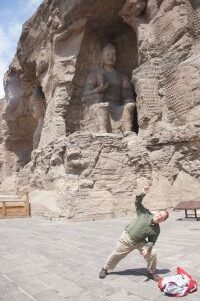 partly by enclosing the most attractive treasures (and that not so coincidentally keeps the coal smoke out). The big statues (some are 60 feet high) are stunning, some of them with the original colors. My guide pointed out that in this early period the Buddhas still had Indian characteristics, though some of the “two Buddha caves” had Buddha heads that looked suspiciously like the Northern Wei emperor and his mom, under whose sponsorship the caves were built; one large statue was carved honoring one of the Wei emperors who tried to eradicate Buddhism—posthumously, of course. With the move to Luoyang in 492, the cave carving petered out, and eventually stopped. We visited 20 of the 49 grottoes; I went on to another 19, and there was only one where I stopped to take a picture.
partly by enclosing the most attractive treasures (and that not so coincidentally keeps the coal smoke out). The big statues (some are 60 feet high) are stunning, some of them with the original colors. My guide pointed out that in this early period the Buddhas still had Indian characteristics, though some of the “two Buddha caves” had Buddha heads that looked suspiciously like the Northern Wei emperor and his mom, under whose sponsorship the caves were built; one large statue was carved honoring one of the Wei emperors who tried to eradicate Buddhism—posthumously, of course. With the move to Luoyang in 492, the cave carving petered out, and eventually stopped. We visited 20 of the 49 grottoes; I went on to another 19, and there was only one where I stopped to take a picture.
From the sublime to “over the top.” In line with the “creation” of a tourist 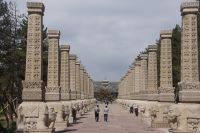

base, the Datong government has recreated a “Northern Wei” palace that has buildings and figures resembling those in the caves, and a “new old” city on the way out, full of merchants offering mostly the same merchandise you see everywhere in China. It is becoming a pattern in China. Get ’em in and keep ’em shopping. I was the only westerner there this morning.
The second flirtation with fame that redounds to Datong’s reputation was the Liao period, the 12th century, when Datong was a first-tier second-tier city, below the capital. It enjoyed imperial blessing again, which led to serious 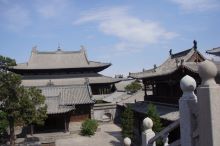
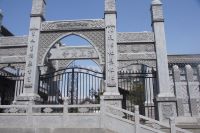 temple building, with a very distinctive art form. Many of the buildings have been destroyed over the years, but a restoration under the Ming/Qing rulers kept some of them intact—and since the 1990s, many more have been reconstructed. Sometimes it is difficult to tell the difference between the old and the “new old.”
temple building, with a very distinctive art form. Many of the buildings have been destroyed over the years, but a restoration under the Ming/Qing rulers kept some of them intact—and since the 1990s, many more have been reconstructed. Sometimes it is difficult to tell the difference between the old and the “new old.”
The third claim to fame is based on its location. As my guide proudly stated, Datong is the only major Chinese city between the Great Wall to keep the northern barbarians out and the inner wall to keep the Chinese in. As a border station, it was important in the Han dynasty (there is a portion of the Han Great Wall here) and the Ming Great Wall (which is in the process of being rebuilt). In fact, there is a major effort by the new mayor to create a new old city, which is already underway. There is a nine-dragon wall that used to be in front of the Ming governor’s palace in the early Ming 
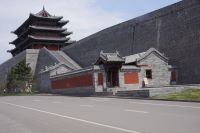 period.
period.
The governor could have a dragon wall because he was the thirteenth son of the Emperor. The wall was moved to a former temple when the palace was torn down years ago, but the wooden frame of its replacement is underway, in a swath of buildings cleared to make the “new old” city.
The new mayor might not have said, “If you build it, they will come,” but he is banking Datong’s future on its past.
Have you moved it higher on your bucket list?